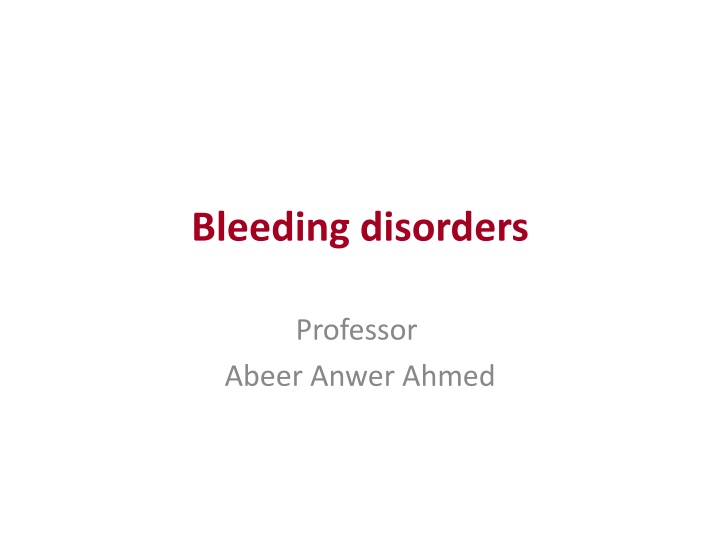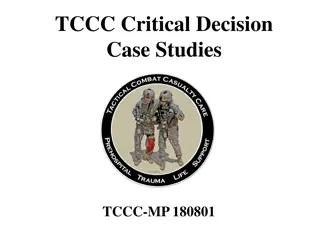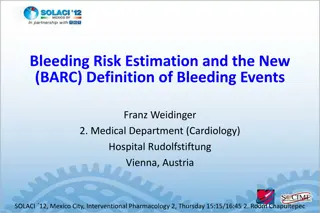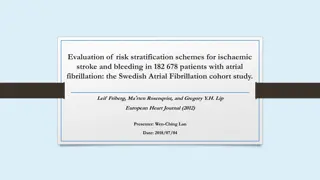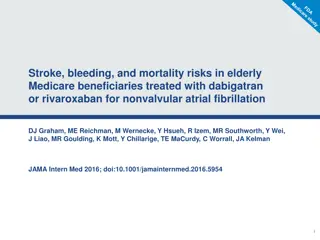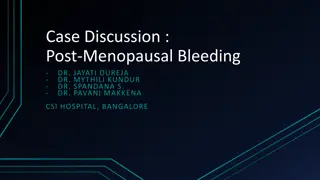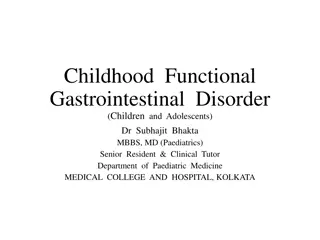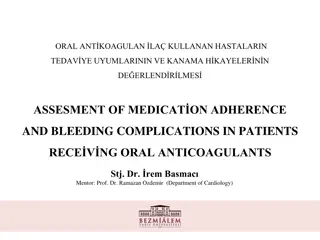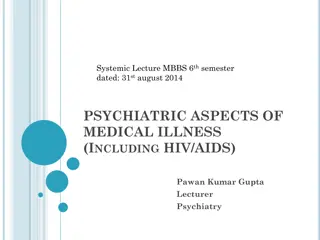Bleeding disorders
Bleeding disorders can arise from vascular abnormalities, platelet defects, or coagulation issues. Vascular bleeding disorders can be inherited or acquired, leading to easy bruising and spontaneous bleeding. Thrombocytopenia, characterized by low platelet count, can also cause abnormal bleeding. Explore the causes and manifestations of these conditions.
Download Presentation

Please find below an Image/Link to download the presentation.
The content on the website is provided AS IS for your information and personal use only. It may not be sold, licensed, or shared on other websites without obtaining consent from the author.If you encounter any issues during the download, it is possible that the publisher has removed the file from their server.
You are allowed to download the files provided on this website for personal or commercial use, subject to the condition that they are used lawfully. All files are the property of their respective owners.
The content on the website is provided AS IS for your information and personal use only. It may not be sold, licensed, or shared on other websites without obtaining consent from the author.
E N D
Presentation Transcript
Bleeding disorders Professor Abeer Anwer Ahmed
Bleeding disorders due to vascular & platelets abnormalities Abnormal bleeding may result from: 1- Vascular disorders 2- Thrombocytopenia (low platelets) 3- Platelet function defects 4- Defective coagulation 5- Abnormalities of fibrinolysis
Vascular bleeding disorders: Are heterogeneous group of conditions characterized by : easy bruising & spontaneous bleeding from small vessels . The underlying abnormalities are : either in the vessels themselves or in the perivascular connective tissue.
Causes of vascular bleeding disorders: 1-Inherited vascular disorders *Hereditary haemorrhagic telangiectasia *Connective tissue disorders In the : Ehlers-Danlos syndrome Pseudoxanthoma elasticum *Giant cavernous haemangioma
2- Acquired vascular defect: Simple easy bruising is common in healthy women especially of childbearing age. Senile purpra due to atrophy of supporting tissues of cutaneous blood vessels. Purpura associated with infections *The Henoch Sconlein syndrome is an immune complex (typeIII) hypersensitivity reaction usually found in children often following acute infection
Acquired vascular defect *Scurvy: In vitamin C deficiency, defective collagen may occure may cause perifollicular petechiae, bruising & mucosal hemorrhage. *Steroid purpura associated with long standing steroid therapy or Cushing syndrome cased by defective vascular supportive tissue. *Other: e.g. auto erythrocyte sensitization, DNA sensitivity,& fat embolism.
Thrombocytopenia: Abnormal bleeding due to thrombocytopenia or abnormal platelets function is also characterized by spontaneous skin purpura & hemorrhage & prolonged bleeding after trauma.
Causes of thrombocytopenia: 1-Failure of platelets production *selective megakaryocyte depression: drug, chemical &viral infection *part of general BM failure: cytotoxic drug, radiotherapy, aplastic anemia, leukemia, MDS, MM, megaloplastic anemia, myelosclerosis & HIV infection.
2-Increased consumption of platelets *Immune: -autoimmune, drug-induced, systemic lupus erythematosis, CLL& lymphoma, infection, heparin, post-transfusional purpura -& isoimmune neonatal purpura. *DIC (disseminated intravascular coagulation). *TTP (thrombotic thrombocytopenia purpura). 3-Abnormal distribution of platelets *splenomegaly 4-Dilutional loss *Massive transfusion of stored blood
Immune thrombocytopenia purpura(ITP) 1- Chronic ITP: This is relatively common disorder ,with highest incidence in women 15-50 y ,it is commonest cause of thrombocytopenia without anemia or neutropenia ,it is usually idiopathic but may be seen in association with other disorders e.g. SLE ,HIV infection, CLL, Hodgkin's disease or autoimmune hemolytic anemia.
Pathogenesis: Platelets sensitization with autoantibody usually IgG result in their premature removal from circulation by cells of RE system. The normal life span of platelets is 7-10 days but in ITP is reduced to few hours. Lightly sensitized platelets mainly destroyed by macrophages in spleen but heavily sensitized platelets or platelets coated with complement as well as IgG mainly destroyed throughout RE system mainly in liver.
Diagnosis: 1- Platelets count 10-50 109/L, Hb & WBC are normal. 2- Blood film shows reduced platelets number & often large. 3-BM shows normal or increased number of megakaryocytes. 4- Sensitive tests to demonstrate anti platelets IgG either alone or with complement or IgM on platelets surface or in serum 5-Antinuclear factor is present in serum of patient with SLE 6-Direct antiglobulin test is positive in case with associated autoimmune hemolytic anemia.
2- Acute ITP: Is most common in children , the mechanism is not well established . In 75% of patients ,the thrombocytopenia & bleeding follow vaccination or/& infection e.g. measles, chicken pox or infectious mononucleosis ,and allergic reaction with immune complex formation & complement deposition on platelet is suspected. Spontaneous remission is usual, but in 5-10% of cases the disease becomes chronic.
Disorders of platelets functions 1-Hereditary disorders Thrombasthenia (Glanzmann's disease) Bernard-Soulier syndrome Storage pool diseases
2-Acquired disorders Antiplatelet drugs :Aspirin Hyperglobulinaemia associated with multiple myeloma or Waldenstrom's disease . Myeloproliferative and myelodysplastic Disorders Uraemia Heparin, dextrans, alcohol and radiographic contrast agents may also cause defective function
DIC (disseminated intravascular coagulation). Wide spread intravascular deposition of fibrin with consumption of coagulation factors & platelets occur as consequence of many disorders which release procoagulant material into the circulation or cause wide spread endothelial damage or platelets aggregation. It may be associated with fulminant hemorrhagic syndrome or run less severe & more chronic course.
Causes of DIC: 1-Infections: gram negative & meningococcal septicaemia, septic abortion &clostridium welchii septiacemia, severe falciparum malaria, & viral infection. 2-Malignancy: widespread mucin-secreating adenocarcinoma& promylocytic leukaemia. 3- Obstetric complication: amniotic fluid embolism, premature separation of placenta, eclampcia& retained placenta 4-Hypersensetivity reactions: Anaphylaxis & incompatible blood transfusion 5- Widespread tissue damage: following surgery or trauma. 6-other: liver failure, snake venoms severe burns, hypothermia, heat stroke, acute hypoxia &vascular malformation.
Lab. Findings: Tests of haemostasis: 1-The platelets count is low 2-Fibrinogen is low. 3- The thrombin time is prolonged 4-high levels of fibrinogen & fibrin degradation products are seen in serum & urine. 5- Test for the fibrin-monomer complex is positive 6- The prothrombin time( PT) & APTT are prolonged. 7-Factor V &VIII activities are reduced
Blood film: There is hemolytic anemia with red cells fragmentation due to their passage through fibrin strands in small vessels.
Hereditary coagulation disorders Deficiency of procoagulant clotting factors results in a reduction in the amount of thrombin generated, leading to impaired clot formation and increased bleeding tendency. Inherited deficiencies of von Willebrand factor is the most common inherited bleeding disorder factorVIIIdeficiency (FVIII), in its severe form, is the most common severe IBD.
Haemophilia A (FVIII deficiency) Haemophilia A (HA) is due to deficiency or complete absence of FVIII. It is caused by mutations in F8 gene, located on the long arm of the X chromosome. For all severities of haemophilia, the estimated incidence is 1 in 5000 live male births. Inheritance is X-linked, with a third of patients having no family history
Haemophilia B (FIX deficiency, Christmas disease) Haemophilia B (HB) is caused by deficiency or complete absence of factor IX (FIX). FIX is a serine protease that forms the intrinsic Xase complex with cofactor FVIIIa and activates FX to FXa, necessary for adequate thrombin generation. The incidence of haemophilia B is one-fifth that of haemophilia A.
Clinical features and investigations The clinical presentation of haemophilia A and B is related to the severity of the disease
Haemophilia A: acute haemarthrosis, massive haemorrhage
Haemophilia A showing severe disability
Laboratory findings Suspicion is key to diagnosis; investigations show: 1 Prolonged activated partial thromboplastin time (APTT) 2 Normal PT and normal platelet function 3 FVIII or FIX clotting assay confirms the diagnosis. 4 In patients with mild FVIII deficiency, evaluation should include an analysis of VWF parameters to exclude VWD. 5 A genetic diagnosis can be undertaken through mutation analysis. This provides information on the phenotype and risk of inhibitor development and helps screen carriers.
von Willebrand disease von Willebrand disease (VWD), due to reduced von Willebrand factor (VWF) function, either quantitative or qualitative, is the most common inherited bleeding disorder. The gene is located on the short arm of human chromosome 12, and inheritance depends on the type of VWD.(autosomal dominant or recessive)
Clinical features Patients experience excessive mucocutaneous bleeding, including easy bruising, oral bleeding, epistaxis, gastrointestinal bleeding, prolonged bleeding from minor trauma and heavy menstrual bleeding The severity of bleeding is highly variable, depending on the absolute level of VWF activity, FVIII level and mutation type. Haemarthroses and muscle haematomas are rare, except in Type 3, where VWF is absent. Women are more severely affected than men at a given VWF level due to heavy menstrual bleeding.
Laboratory investigations 1 VWF: Ag (antigen) levels are measured by ELISA assay, a measure of protein concentration. 2 VWF functional assay
